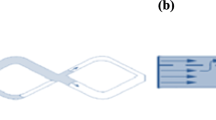Abstract
A major issue in Liquid Composite Molding Process (LCM) concerns the reduction of voids formed during the resin filling process. Reducing the void content increases the quality of the composite and improves its mechanical properties. Most of modeling efforts on process simulation of mold filling has been focused on the single phase Darcy’s law, with resin as the only phase, ignoring the formation and transport of voids. The resin flow in a partially saturated region can be characterized as two phase flow through a porous medium. The mathematical formulation of saturation in LCM takes into account the interaction between resin and air as it occurs in a two phase flow. This model leads to the introduction of relative permeabilities as a function of saturation. The modified saturation equation is obtained as a result, which is a non-linear advection-diffusion equation with viscous and capillary phenomena. In this work, a flux limiter technique has been used to solve a modified saturation equation for the LCM process. The implemented algorithm allows a numerical optimization of the injected flow rate which minimizes the micro/macroscopic void formation during mold filling. Some preliminary numerical results are presented here in order to validate the proposed mathematical model and the numerical scheme. This formulation opens up new opportunities to improve LCM flow simulations and optimize injection molds.










Similar content being viewed by others
References
Trochu F, Ruiz E, Achim V, Soukane S (2004) New approaches to accelerate calculations and improve accuracy of numerical simulations in liquid composite molding, 7th International Conference on Flow Processes in Composite Materials (FPCM-7), Delaware, USA July 2004
Ruiz E, Achim V, Soukane S, Trochu F, Bréard J (2006) Optimization of injection flow rate to minimize micro/macro-voids formation in resin transfer molded composites. Compos Sci Technol 66:475–486
García JA, Gascón L, Chinesta F (2010) A flux limiter strategy for solving the saturation equation in RTM process simulation. Composites: Part A 41:78–82
Sánchez F, García JA, Gascón L, Chinesta F (2007) Towards an efficient numerical treatment of the transport problems in the resin transfer molding simulation. Comput Methods Appl Mech Eng 196:2300–2312
Breard J, Saouab A, Bouquet G (2003) Numerical simulation of void formation in LCM. Composites: Part A 34:517–523
Sweby PK (1984) High resolution schemes using flux limiters for hyperbolic conservation laws. SIAM J Numer Anal 995–1011
PAM-RTM 2008 © ESI Group
Acknowledgments
This research work is supported by a grant from the Ministerio de Educación y Ciencia (MEC), project DPI2007-66723-C02-01.
Author information
Authors and Affiliations
Corresponding author
Rights and permissions
About this article
Cite this article
García, J.A., Gascón, L., Chinesta, F. et al. An efficient solver of the saturation equation in liquid composite molding processes. Int J Mater Form 3 (Suppl 2), 1295–1302 (2010). https://doi.org/10.1007/s12289-010-0681-8
Received:
Accepted:
Published:
Issue Date:
DOI: https://doi.org/10.1007/s12289-010-0681-8




